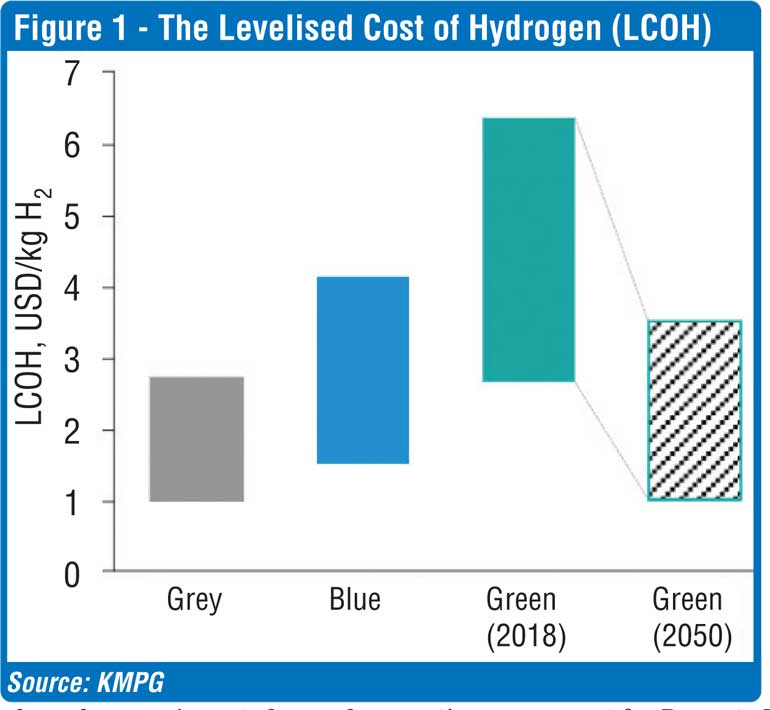Monday Jan 19, 2026
Monday Jan 19, 2026
Wednesday, 14 December 2022 00:00 - - {{hitsCtrl.values.hits}}

 Hydrogen is a light element; however, one kilogram of it carries an equivalent energy of 1 gallon of gasoline (2.767 kilograms equivalent). This remarkably high energy capacity makes hydrogen a thriving candidate as an energy carrier and a storage medium. Further, a series of unique chemical and physical properties of this light, flammable, odourless and non-toxic gas makes it an essential feedstock for industrial and individual uses. The annual global production of hydrogen has reached 94 million tonnes in 2021 according to the International Energy Agency (IEA).
Hydrogen is a light element; however, one kilogram of it carries an equivalent energy of 1 gallon of gasoline (2.767 kilograms equivalent). This remarkably high energy capacity makes hydrogen a thriving candidate as an energy carrier and a storage medium. Further, a series of unique chemical and physical properties of this light, flammable, odourless and non-toxic gas makes it an essential feedstock for industrial and individual uses. The annual global production of hydrogen has reached 94 million tonnes in 2021 according to the International Energy Agency (IEA).
Predominantly, hydrogen is used in the chemical and petrochemical industries; however, it has been projected to create new avenues in industries such as steel, shipping, aviation, long-haul transport, and light vehicles. This creates a rapid growth of global demand for hydrogen which has been predicted to reach 610 million tonnes per year by 2050. As per current practices, Steam Methane Reforming (SMR) and Coal Gasification are the two main methods of hydrogen production. In both options, carbon dioxide is emitted in large quantities. In 2020 alone SMR and Coal gasification together emitted 900 million tonnes of carbon dioxide into the atmosphere and this value is equal to the collective emissions of a few industrial nations. Carbon dioxide emission from SMR and Coal gasification is a huge burden, especially on nations committed to the Paris Agreement which strongly obligates them to reach net zero targets by 2050.
Hydrogen is a colourless gas; even its flame at complete combustion is invisible. However, a colour code for hydrogen has been established according to its production methods and the coping mechanisms with carbon dioxide emission. Coal gasification, which is considered the most polluting method of hydrogen production is classified as brown. SMR which is currently the largest method of hydrogen production, and the second most polluting process is classified as grey. As both grey and brown hydrogen possesses a serious impact on the environment, a novel class of hydrogen can be seen emerging. It is green hydrogen.
Green hydrogen is defined as hydrogen produced by electrolysis of water using renewable electricity. This method complies with net-zero requirements especially since the electrochemical reaction does not emit a single atom of carbon dioxide in association with the conversion process on contrary to the SMR and Coal Gasification. Green hydrogen holds a significant promise to meet the complex energy needs of the modern world while helping to meet climate action goals. Green hydrogen has a significant advantage in achieving climate targets over grey and brown hydrogen which presently cater 98% of the today’s hydrogen market.
However, green hydrogen’s fate is not only to replace grey and brown hydrogen. It has demonstrated the ability to cater entirely for new avenues. It is emerging as an energy storage which can deploy to mitigate imbalances that occurred in the modern grids due to intermittent nature of renewable energy sources. Further, green hydrogen contributes to bridging sectors which are difficult to connect with renewable energy such as steel, chemicals, long-haul transport, shipping and aviation. These untapped potentials make green hydrogen a truly remarkable concept.
Green Hydrogen Economy is unique. The success formula in it lies behind the knowledge, capital, potential of renewable energy sources, and strategic location of the nation. The unit price of green hydrogen is driven by the scaling-up strategy, innovations and availability of renewable electricity at a competitive price. With current development, green hydrogen price is predicted to reach a scale of $ 1 to $ 3 per kilogram by 2050 (Figure 01). The nations which reached the bottom of this scale will be winners and the race has already begun. Many developing nations such as Namibia, Kenya, Mauritania, Egypt, Tunisia, Kazakhstan, and India have already committed billions of dollars of investments with financial and technical support from developed countries such as Japan, Germany, France, Norway, and corporation such as Masdar, BP, Shell, ITM Power, Linde, Nel, Cummings, and Fortescue Future Industries.
It is worth noting that African nations are ambitiously focusing on capturing 10% of the world’s green hydrogen market by 2050. They are targeting to secure an additional $ 60 to $ 120 billion in GDP with green hydrogen-related investments. As an island nation with ample potential in renewable energy sources and its strategic location as a maritime hub, does Sri Lanka want to be left out of this race?
As a tropical island on the equator, Sri Lanka is blessed with many renewable energy sources, which is the prime mover of green hydrogen economy. Having only two seasons of monsoonal rains, Sri Lanka is mostly having a dry climate for the rest of the year which maximises its window to grab full potentials of solar power. Further, as an island nation, onshore and offshore wind potentials are enormous. The Sri Lankan Government has already started tapping much of these potentials with projects such as Thambapavani wind farm in Mannar. With the increasing global demand for green hydrogen, capturing a significant market share will be an advantage for the country’s economy. If we secure our place as a green hydrogen producer and exporter, we can secure the opportunity to fuel the shipping and aviation industry which can be seen transitioning towards green hydrogen.
Further green hydrogen will fuel the establishment of a local fertiliser industry avoiding dependency on Ukraine and Russia. In parallel to the advancement of green hydrogen, two electrochemical methods are being developed where the production of ammonia and urea can be driven with renewable electricity using water, nitrogen, and green hydrogen as feedstocks. This will give us complete freedom from the dependency on imports for our fertiliser needs.
Further, the nature of the electrochemical process will let us develop scalable production processes which can be flexible for the needs and state of our economy.
Further, green hydrogen is growing as a promising way of multilevel energy storage which can be deployed to mitigate imbalances that occurred in the grids due to the intermittent nature of renewable energy sources. As a progressing nation, we can opt for Power-to-X model where these grid imbalances can be converted to strategic chemicals such as ammonia and urea which will solve one of our burning issues in the agriculture industry. More importantly, green hydrogen can contribute to bridging sectors which are difficult to connect with renewable energy such as steel, glass, ceramic, aluminium, and cement industries through technologies such as direct reduction.
As a nation, we are not at zero when it comes to green hydrogen. The Petroleum Development Authority (PDASL) has already initiated a collaboration with Greenstat Hydrogen India Ltd., which is an affiliated body of Greenstat AS, Norway. They are conducting a techno-economic feasibility analysis of a green hydrogen plant in Sri Lanka. The Sri Lanka Energy Managers Association (SLEMA) in partnership with Asian Development Bank has formed a special interest group and they recently held a public webinar under the theme ‘Green Hydrogen (GH2) – Opportunities and Challenges for Sri Lanka’. More interestingly during two recent visits to Trincomalee and Mannar, President Ranil Wickremesinghe stressed the importance of green hydrogen for the building economy in Sri Lanka.
As Mr. President rightfully said at the COP27 summit, the unbridled industrialisation of developed countries is the root cause of climate change which left the poor nation to suffer the consequences. And a golden opportunity has reached our doorstep to be a model nation taking strong actions to save the world from an evitable crisis coming upon us. It is not just the climate crisis, green hydrogen will create an economy which will reduce our dependency on fossil fuels and convert us to a net exporter in the booming energy market. Further, it will decentralise the fertiliser industry with scalability matching our needs and economy.
Amid the worst financial crisis our nation ever faced, can we be hopeful for a path which may lead Sri Lanka to its rightful position? Green hydrogen is a promising path, we are at a critical moment in figuring out our journey on it.
(The writer is a Senior Lecturer at the Department of Chemical and Process Engineering, University of Moratuwa. He is open to connecting with green hydrogen initiatives in Sri Lanka to offer his knowledge and experience in Chemical and Process Engineering. He can be reached by emailing [email protected]. The author acknowledges the following persons for the various support given for this report. Senior Professor Ajith de Alwis, Professor Shantha Maduwage Egodage, Divya Karunasena and Lahiru Himal from the Department of Chemical and Process Engineering, Faculty of Engineering, University of Moratuwa. A Green Hydrogen interest group consists of the following key members: Tissa Liyanage – Paranthan Company Ltd., Veditha de Silva, Faculty of Engineering, University of Ruhuna, Susiri Costa, University of Melbourne and a few other Young Chemical Engineers.)